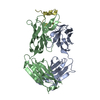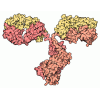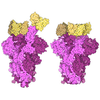+ Open data
Open data
- Basic information
Basic information
| Entry | Database: PDB / ID: 9cqd | ||||||
|---|---|---|---|---|---|---|---|
| Title | Antibody 2B11 bound to the central conserved domain of RSV G | ||||||
 Components Components |
| ||||||
 Keywords Keywords | VIRAL PROTEIN/IMMUNE SYSTEM / antibody / respiratory syncytial virus / G glycoprotein / VIRAL PROTEIN / VIRAL PROTEIN-IMMUNE SYSTEM complex | ||||||
| Function / homology |  Function and homology information Function and homology informationTranslation of respiratory syncytial virus mRNAs / adhesion receptor-mediated virion attachment to host cell / RSV-host interactions / Maturation of hRSV A proteins / Assembly and release of respiratory syncytial virus (RSV) virions / Respiratory syncytial virus (RSV) attachment and entry / symbiont entry into host cell / host cell plasma membrane / virion membrane / extracellular region / plasma membrane Similarity search - Function | ||||||
| Biological species |  Respiratory syncytial virus A2 Respiratory syncytial virus A2 Homo sapiens (human) Homo sapiens (human) | ||||||
| Method |  X-RAY DIFFRACTION / X-RAY DIFFRACTION /  SYNCHROTRON / SYNCHROTRON /  MOLECULAR REPLACEMENT / Resolution: 3.1 Å MOLECULAR REPLACEMENT / Resolution: 3.1 Å | ||||||
 Authors Authors | Juarez, M.G. / DuBois, R.M. | ||||||
| Funding support |  United States, 1items United States, 1items
| ||||||
 Citation Citation |  Journal: Sci Rep / Year: 2025 Journal: Sci Rep / Year: 2025Title: Structures of respiratory syncytial virus G bound to broadly reactive antibodies provide insights into vaccine design. Authors: Maria G Juarez / Sara M O'Rourke / John V Dzimianski / Delia Gagnon / Gabriel Penunuri / Vitor H B Serrão / Russell B Corbett-Detig / Lawrence M Kauvar / Rebecca M DuBois /  Abstract: Respiratory syncytial virus (RSV) is a leading cause of severe lower respiratory tract disease in infants and older adults. The attachment glycoprotein (RSV G) binds to the chemokine receptor CX3CR1 ...Respiratory syncytial virus (RSV) is a leading cause of severe lower respiratory tract disease in infants and older adults. The attachment glycoprotein (RSV G) binds to the chemokine receptor CX3CR1 to promote viral entry and modulate host immunity. Antibodies against RSV G are a known correlate of protection. Previously, several broadly reactive, high-affinity anti-RSV G human monoclonal antibodies were isolated from RSV-exposed individuals and were shown to be protective in vitro and in vivo. Here, we determined the structures of three of these antibodies in complex with RSV G and defined distinct conformational epitopes comprised of highly conserved RSV G residues. Binding competition and structural studies demonstrated that this highly conserved region displays two non-overlapping antigenic sites. Analyses of anti-RSV G antibody sequences reveal that antigenic site flexibility may promote the elicitation of diverse antibody germlines. Together, these findings provide a foundation for next-generation RSV prophylactics, and they expand concepts in vaccine design for the elicitation of germline lineage-diverse, broadly reactive, high-affinity antibodies. | ||||||
| History |
|
- Structure visualization
Structure visualization
| Structure viewer | Molecule:  Molmil Molmil Jmol/JSmol Jmol/JSmol |
|---|
- Downloads & links
Downloads & links
- Download
Download
| PDBx/mmCIF format |  9cqd.cif.gz 9cqd.cif.gz | 745.3 KB | Display |  PDBx/mmCIF format PDBx/mmCIF format |
|---|---|---|---|---|
| PDB format |  pdb9cqd.ent.gz pdb9cqd.ent.gz | 526.7 KB | Display |  PDB format PDB format |
| PDBx/mmJSON format |  9cqd.json.gz 9cqd.json.gz | Tree view |  PDBx/mmJSON format PDBx/mmJSON format | |
| Others |  Other downloads Other downloads |
-Validation report
| Summary document |  9cqd_validation.pdf.gz 9cqd_validation.pdf.gz | 631.5 KB | Display |  wwPDB validaton report wwPDB validaton report |
|---|---|---|---|---|
| Full document |  9cqd_full_validation.pdf.gz 9cqd_full_validation.pdf.gz | 694.9 KB | Display | |
| Data in XML |  9cqd_validation.xml.gz 9cqd_validation.xml.gz | 128.4 KB | Display | |
| Data in CIF |  9cqd_validation.cif.gz 9cqd_validation.cif.gz | 166.5 KB | Display | |
| Arichive directory |  https://data.pdbj.org/pub/pdb/validation_reports/cq/9cqd https://data.pdbj.org/pub/pdb/validation_reports/cq/9cqd ftp://data.pdbj.org/pub/pdb/validation_reports/cq/9cqd ftp://data.pdbj.org/pub/pdb/validation_reports/cq/9cqd | HTTPS FTP |
-Related structure data
| Related structure data |  9cqaC  9cqbC C: citing same article ( |
|---|---|
| Similar structure data | Similarity search - Function & homology  F&H Search F&H Search |
- Links
Links
- Assembly
Assembly
| Deposited unit | 
| ||||||||||||
|---|---|---|---|---|---|---|---|---|---|---|---|---|---|
| 1 | 
| ||||||||||||
| 2 | 
| ||||||||||||
| 3 | 
| ||||||||||||
| 4 | 
| ||||||||||||
| 5 | 
| ||||||||||||
| 6 | 
| ||||||||||||
| 7 | 
| ||||||||||||
| 8 | 
| ||||||||||||
| Unit cell |
|
- Components
Components
| #1: Protein/peptide | Mass: 5735.633 Da / Num. of mol.: 8 Source method: isolated from a genetically manipulated source Source: (gene. exp.)  Respiratory syncytial virus A2 / Production host: Respiratory syncytial virus A2 / Production host:  #2: Antibody | Mass: 27321.760 Da / Num. of mol.: 8 Source method: isolated from a genetically manipulated source Source: (gene. exp.)  Homo sapiens (human) / Production host: Homo sapiens (human) / Production host:  #3: Antibody | Mass: 23517.857 Da / Num. of mol.: 8 Source method: isolated from a genetically manipulated source Source: (gene. exp.)  Homo sapiens (human) / Production host: Homo sapiens (human) / Production host:  Has protein modification | Y | |
|---|
-Experimental details
-Experiment
| Experiment | Method:  X-RAY DIFFRACTION / Number of used crystals: 1 X-RAY DIFFRACTION / Number of used crystals: 1 |
|---|
- Sample preparation
Sample preparation
| Crystal | Density Matthews: 2.39 Å3/Da / Density % sol: 48.59 % |
|---|---|
| Crystal grow | Temperature: 295.15 K / Method: vapor diffusion, hanging drop / Details: 0.22M Ammonium Citrate Dibasic and 15% PEG 3350 |
-Data collection
| Diffraction | Mean temperature: 100 K / Serial crystal experiment: N |
|---|---|
| Diffraction source | Source:  SYNCHROTRON / Site: SYNCHROTRON / Site:  ALS ALS  / Beamline: 5.0.1 / Wavelength: 0.97 Å / Beamline: 5.0.1 / Wavelength: 0.97 Å |
| Detector | Type: DECTRIS PILATUS 6M / Detector: PIXEL / Date: Nov 12, 2023 |
| Radiation | Protocol: SINGLE WAVELENGTH / Monochromatic (M) / Laue (L): M / Scattering type: x-ray |
| Radiation wavelength | Wavelength: 0.97 Å / Relative weight: 1 |
| Reflection | Resolution: 3.1→92.17 Å / Num. obs: 78391 / % possible obs: 100 % / Redundancy: 13.2 % / Biso Wilson estimate: 67.15 Å2 / CC1/2: 0.984 / Net I/σ(I): 3.3 |
| Reflection shell | Resolution: 3.1→3.15 Å / Num. unique obs: 3862 / CC1/2: 0.348 |
- Processing
Processing
| Software |
| ||||||||||||||||||||||||||||||||||||||||||||||||||||||||||||||||||||||||||||||||||||||||||||||||||||||||||||||||
|---|---|---|---|---|---|---|---|---|---|---|---|---|---|---|---|---|---|---|---|---|---|---|---|---|---|---|---|---|---|---|---|---|---|---|---|---|---|---|---|---|---|---|---|---|---|---|---|---|---|---|---|---|---|---|---|---|---|---|---|---|---|---|---|---|---|---|---|---|---|---|---|---|---|---|---|---|---|---|---|---|---|---|---|---|---|---|---|---|---|---|---|---|---|---|---|---|---|---|---|---|---|---|---|---|---|---|---|---|---|---|---|---|---|
| Refinement | Method to determine structure:  MOLECULAR REPLACEMENT / Resolution: 3.1→80.04 Å / SU ML: 0.647 / Cross valid method: FREE R-VALUE / σ(F): 1.34 / Phase error: 37.2419 MOLECULAR REPLACEMENT / Resolution: 3.1→80.04 Å / SU ML: 0.647 / Cross valid method: FREE R-VALUE / σ(F): 1.34 / Phase error: 37.2419 Stereochemistry target values: GeoStd + Monomer Library + CDL v1.2
| ||||||||||||||||||||||||||||||||||||||||||||||||||||||||||||||||||||||||||||||||||||||||||||||||||||||||||||||||
| Solvent computation | Shrinkage radii: 0.9 Å / VDW probe radii: 1.1 Å / Solvent model: FLAT BULK SOLVENT MODEL | ||||||||||||||||||||||||||||||||||||||||||||||||||||||||||||||||||||||||||||||||||||||||||||||||||||||||||||||||
| Displacement parameters | Biso mean: 74.5 Å2 | ||||||||||||||||||||||||||||||||||||||||||||||||||||||||||||||||||||||||||||||||||||||||||||||||||||||||||||||||
| Refinement step | Cycle: LAST / Resolution: 3.1→80.04 Å
| ||||||||||||||||||||||||||||||||||||||||||||||||||||||||||||||||||||||||||||||||||||||||||||||||||||||||||||||||
| Refine LS restraints |
| ||||||||||||||||||||||||||||||||||||||||||||||||||||||||||||||||||||||||||||||||||||||||||||||||||||||||||||||||
| LS refinement shell |
|
 Movie
Movie Controller
Controller




 PDBj
PDBj

